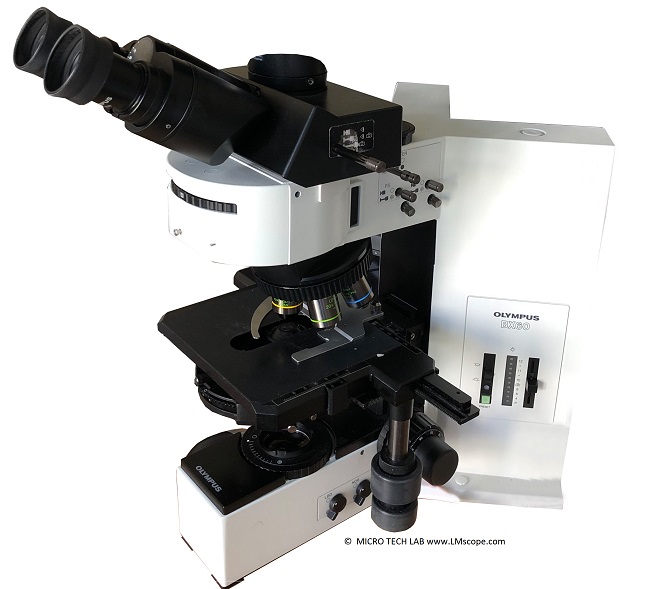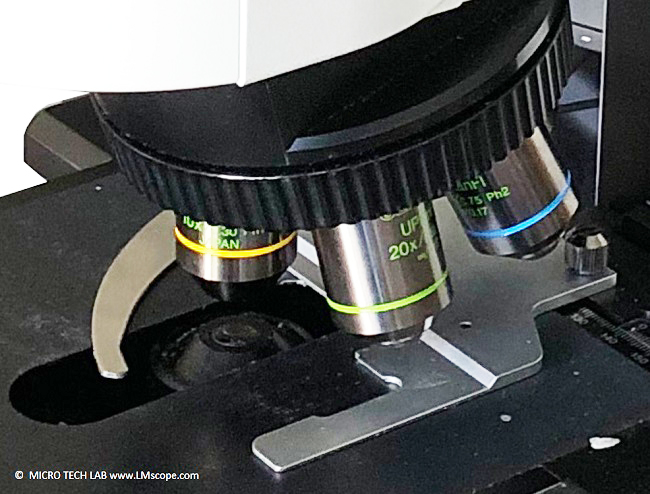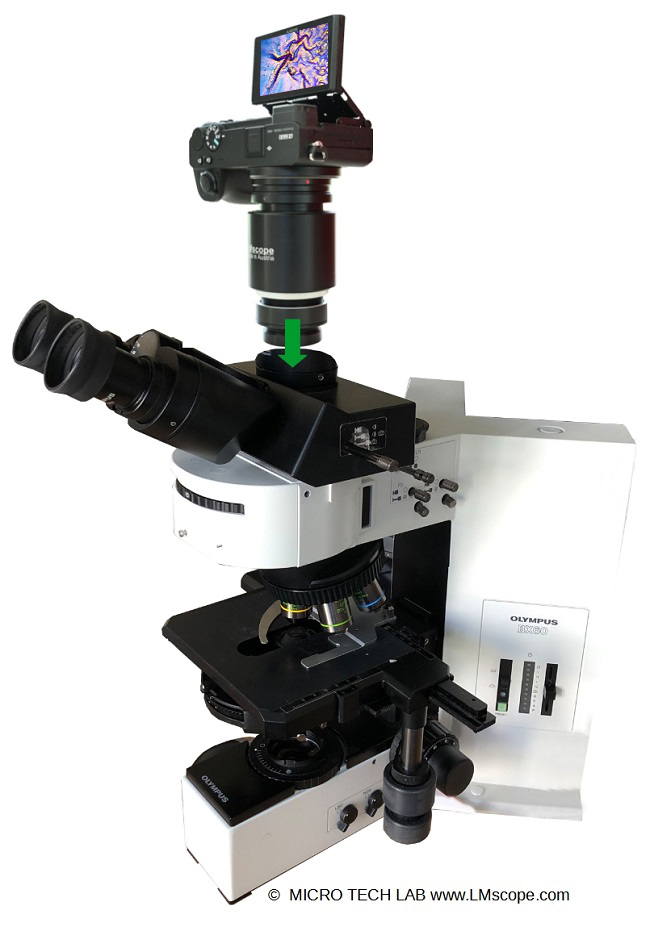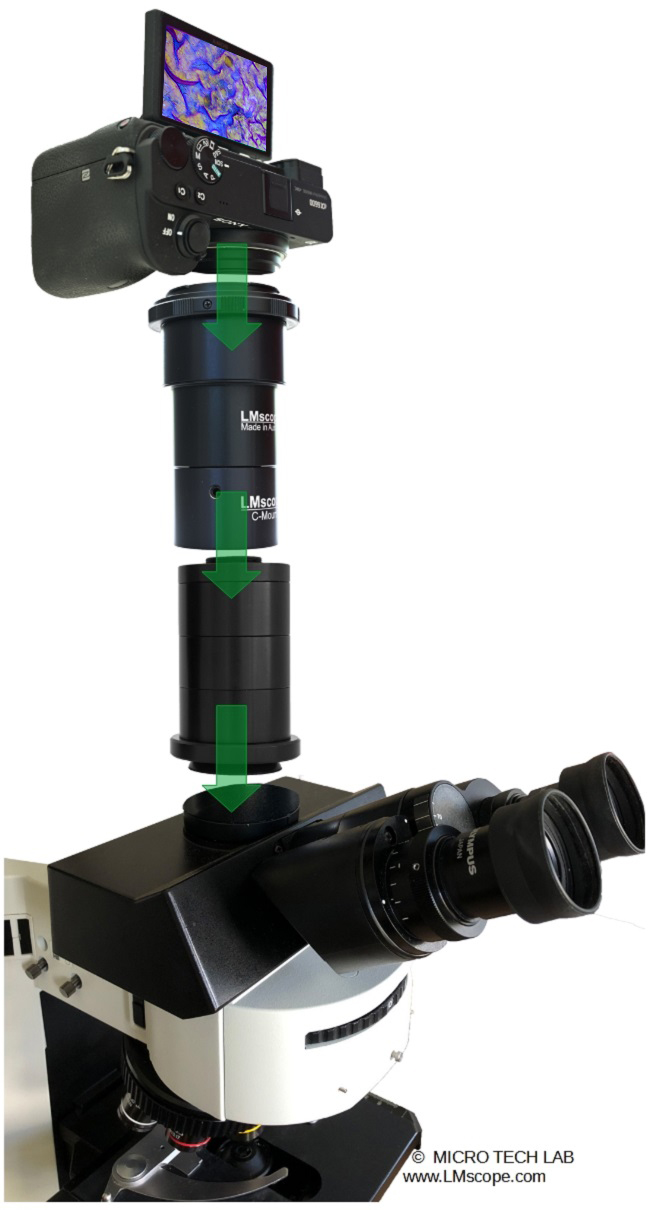

Olympus BX60: elevate your imaging and create high-quality photos and videos with the latest camera systems and our versatile LM adapter solutions
Our LM digital adapters offer unparalleled flexibility in terms of camera selection, allowing users to fully leverage the benefits of modern digital cameras – DSLRs, mirrorless system cameras, special-purpose microscope cameras, C-mount cameras, digital medium format cameras or high-speed cameras – when used for microscope applications.
The Olympus BX60 laboratory microscope is part of the first Olympus BX series (BX40, BX50 and BX60) which was launched in 1993. It is equipped with the acclaimed Olympus UIS infinity-corrected optical system and still delivers remarkable image quality today. With our LM adapter solutions, this microscope seamlessly integrates with the latest digital cameras.

Designed to support a broad spectrum of research fields (biology, medicine, materials science environmental studies and many more), the BX series stands out for its modular design and extensive accessory options (including various phototubes, multi-observer discussion tubes for up to ten persons, a drawing tube, etc.), making the BX60 exceptionally versatile. With the requisite accessories, it accommodates a wide range of observation techniques such as brightfield, darkfield, Nomarski DIC, simple polarisation and fluorescence observation.

It can be equipped with a quintuple or sextuple forward- or reverse-facing objective turret which accommodates a comprehensive range of infinity-corrected objective lenses. Recommended objectives include:
• Achromats (10x–100x)
• Plan achromats (4x–100x)
• U Plan apo objectives (4x–100x)
• Plan apo objectives (1.25x–100x)
• U Plan fluorite objectives
• Specialised objectives for metallurgy
Depending on the objective lens used, a maximum working distance of 22 mm can be achieved (with the plan achromat 4x).
For photographic work, the stability of the microscope is crucial because even the slightest vibration can cause motion blur, especially at higher magnifications. The BX60 stands out in this regard, thanks to its Y-shaped design and substantial weight of more than 11 kg, offering a solid foundation for precision work.
Olympus offers a number of different tube options which can be equipped with a contemporary system camera, DSLR, microscope camera, high-speed camera, etc. with our adapter solutions, featuring built-in precision optics for quick and effortless connections.
1) Binocular tubes U-TBI or U-BI30: Here, one of the eyepieces (30 mm internal diameter) is removed and the camera-adapter unit is put into its place.

2) Phototubes U-TR30, U-SWTR, U-DPT (dual photo port with U-TV 1x)
If the microscope has a phototube (such as the U-TR30 binocular viewing head with 42 mm internal diameter), the camera can be attached directly to the phototube. We offer the following two connection options: our compact direct adapter and our modular, flexible widefield adapter, which can also be used with other microscopes. The best way to determine the product that optimally fits your requirements is to have a one-on-one conversation with us – please feel free to get in touch.

Compact solution with the direct microscope adapter

Modular widefield adapter
The BX60 frequently was outfitted with a U-DPT dual photo port with 1x C-mount, which accommodates our C-mount widefield adapter.
If your microscope has an original photographic unit designed for analogue systems, you can find information on how to convert it here.
Conclusion: Even older microscopes like the Olympus BX60 are perfectly capable of keeping up with modern demands. Equipped with UIS (Universal Infinity System) objectives, known for their superior optical performance and high colour fidelity, they produce photographs and videos of remarkable quality when used with modern camera systems. Our adapter solutions provide the flexibility and ease of use needed to maximise their potential.
08.11.2024Photography:
Fitting the microscope to digital single-lens reflex (DSLR), mirrorless interchangeable-lens cameras (MILC ), digital single-lens mirrorless (DSLM) or C-mount cameras is easy with our LM digital SLR adapters, which feature a plan achromatic optical system. Our products make it possible to capture top-quality microscope images. To help you select the adapter that is right for your camera, we have set up an online configurator on our website. You can also email us – ideally with attached photographs of your microscope.
Modern DSLR and single-lens mirrorless (DSLM) offer the latest technology and are generally very well suited for microscopy applications. Most of them can be controlled remotely via PC/Mac. Because of their high sales volumes, they offer an excellent price/performance ratio compared to special-purpose microscope cameras.
Features of top DSLR and single-lens mirrorless cameras (DSLM):
- Large, powerful full-frame sensors (36 x 24 mm)
- Sensor resolution of 61 megapixels or 240 megapixels with Pixel Shift technology
- High light sensitivity (ISO 400,000+)
- Extensive dynamic range (up to 15 aperture stops/f-stops)
- Short exposure times (1/8000 second) up to 1/32,000 seconds using the digital shutter
- 4K Ultra HD or 8K Ultra HD video function
- Live video capture on external monitors in ultra HD quality
In most cases, these cameras are significantly more powerful than microscope cameras with smaller sensors (1/2" or 2/3"). On our website you will find our current camera recommendations and a camera ranking which is specifically tailored to microscopy applications.